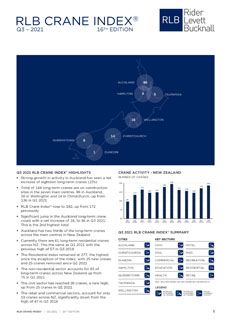Auckland has recorded significant net increase of 18 cranes over the past six months with 144 long-term cranes across NZ’s seven centres.
Despite the lockdowns, delays in material supply, increased shipping costs and pressure on local labour resources due to the impacts of COVID-19, Auckland’s construction market has proved remarkedly resilient with the net addition of 18 construction cranes on projects over the past six months.
According to today’s release of the Q3 2021 RLB Crane Index®, New Zealand now has 144 long-term cranes on construction sites across the seven main centres, up from 136 in Q1 2021. 96 cranes in Auckland, 16 in Wellington, 4 in Christchurch, 8 in Queenstown, 5 in Tauranga, 4 in Hamilton, and 1 in Dunedin.
Construction in Auckland bounces back
Rider Levett Bucknall Director Mr Chris Haines said, “Auckland’s status as the engine room of New Zealand continues with its’ 96 cranes accounting for two-thirds of the 144 cranes sighted across the main centres in the country.
He continued, “Interestingly, this is the second highest total number of cranes sighted in Auckland after 16 editions of the RLB Crane Index over the last 8 years. Construction in the city has certainly bounced back strongly which is a combination of a buoyant residential sector and a strong civil infrastructure sector, which includes some ‘shovel ready’ projects now on site, together with projects such as the City Rail Link and Watercare’s Central Interceptor which are now very active across multiple site locations.”
“With construction activity recommencing a few weeks ago across the country and Level 3 in Auckland looking likely soon, materials shortages remain a key issue for the industry as they were before lockdown. These maybe further magnified for a time given local manufacturing and logistics were shutdown. The ‘remobilisation’ of construction sites may take some time on certain projects depending on their place in the queue” he said.
“Level 3 protocols may have only a modest impact on productivity on construction sites but materials will be a key focus for contractors,” he added.
The latest RLB latest Crane Index found that there are 61 long-term Residential cranes across NZ, the same number as Q1 2021 with the previous high of 57 being in Q3 2018.
Supply issues and escalation pressures still challenging
In Auckland, there has been a high churn-rate of Residential cranes with 19 removed and 19 put in place in the last six months. The sector remains strong but current supply issues and escalation pressures are making fixed pricing and lump sum prices sometimes challenging in the market.
Mr Haines noted, “Banks are increasingly demanding fixed price contracts and lower risk profiles. These constraints on lending for developers is seeing continued reliance on second tier lenders and mezzanine funding.”
The Non-Residential sector accounts for 83 of long-term cranes across New Zealand, up from 75 in Q1 2021. The Civil and Infrastructure sector is currently very strong as a product of the government ‘s implementation of ‘shovel ready’ projects now on site in many cases. This sector has reached 28 long-term cranes, a new high, up from 25 cranes in Q1 2021.
The Retail and Commercial sectors,which account for only 19 cranes across NZ is significantly down from the high of 47 in Q3 2018.
Apart from Auckland’s buoyant construction market, the majority of the country’s centres recorded a slight decrease in the number of cranes sighted over the past six months.
Wellington remains buoyant
As identified in previous publications, the construction market in Wellington remains buoyant in the post-COVID environment and remains the most consistent and least impacted centre, with a strong and reliable pipeline of government related work. The removal of all cranes from the Health and Hotel sectors resulted in a total of 16 long-term cranes being now on projects compared to 18 on projects in the Wellington region in the previous count. Supply chain constraints and limited market capacity remain significant issues in the Wellington market which is being impacted by escalating costs and longer construction durations.
Christchurch crane activity falls
Christchurch’scrane activity for the Q3 2021 has fallen for the first time since Q1 2019. With a net decrease of one crane, Christchurch’s long-term crane count has fallen to 14. The city saw the addition of three new long-term cranes, while four were removed from projects across the region.
The increase in crane numbers follows a 10% fall in consents recorded for the year ending December 2020, Total consents for Canterbury $3.0b down from $3.4b in 2019. Work Put in Place for the year was down 10% in 2020, mainly due to a sharp drop in non-residential work which fell 20% over 2019 levels.
Uncertainty in hotel and commercial sectors continues
Queenstown’s crane numbers have dropped from 15 six months ago to eight cranes today. Smaller projects with shorter durations are typical in this market resulting in more crane churn. Continued uncertainty in the hotel and commercial sectors has been reflected in this index with both the hotel and commercial sectors having no active cranes. Only the education sector saw an increase in crane numbers with the only other active sector, residential recording a small net drop in crane numbers.
Despite the impacts of COVID-19, and initial forecasts of significant drops in building activity, the twelve months to March 2021 has seen only a 1.1% decline in total building activity across the country. This was mainly seen in the non-residential sectors which decreased 8.9%. This was offset by a strong rise in residential activity of 3.4%.
Building consents up for residential and non-residential
Mr Haines concluded, “The forward pipeline remains very strong with building consents for the country up by 17.7% for the twelve months to June 2021. Total consents for the twelve months totalled $26.4b, up from $22.5b for the twelve months to 30 June 2020. All regions’ consents are up from the previous 12 months which gives confidence to levels activity within the current pipeline of activity. Both residential and non-residential consents increased substantially over the past 12 months to June 2021 with increases of 19.7% and 13.1% respectively.”
“Material supply issues, cost escalation and lack of construction sector workers due to boarder restrictions, have been challenging issues for the industry during 2021. Looking forward, solving both material supply constraints and oversees skilled workers will be a key focus for the industry in 2022 to be able to deliver the strong forward pipeline,” he said.
FURTHER INFORMATION:



